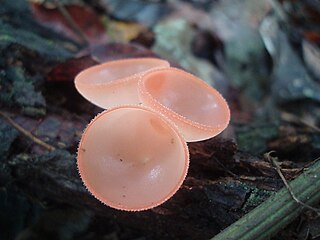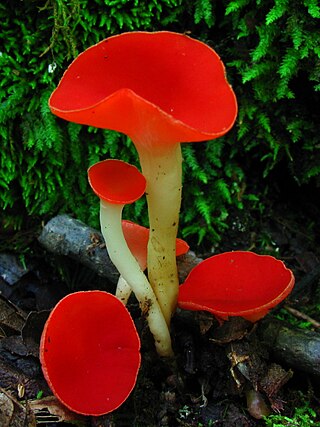Related Research Articles

Orson Knapp Miller Jr. was an American mycologist. He published numerous papers in mycology and was responsible for the naming of many taxa, as well as being one of the authors erecting the genus Chroogomphus. He described Omphalotus olivascens, several species of Amanita, and the ghoul fungus Hebeloma aminophilum.

Cookeina is a genus of cup fungi in the family Sarcoscyphaceae, members of which may be found in tropical and subtropical regions of the world. Species may be found on fallen branches of angiosperms, trunks, and sometimes on fruits. The Temuans of Peninsular Malaysia are reported to use certain species from this genus as food, and also as a bait for fishing, where it is rubbed against the hook.
Smardaea is a genus of fungi in the family Pyronemataceae.

Chorioactis is a genus of fungi that contains the single species Chorioactis geaster. The mushroom is commonly known as the devil's cigar or the Texas star in the United States, while in Japan it is called kirinomitake (キリノミタケ). This extremely rare mushroom is notable for its unusual appearance and disjunct distribution; it is found only in select locales in Texas and Japan. The fruit body, which grows on the stumps or dead roots of cedar elms or dead oaks, somewhat resembles a dark brown or black cigar before it splits open radially into a starlike arrangement of four to seven leathery rays. The interior surface of the fruit body bears the spore-bearing tissue known as the hymenium, and is colored white to brown, depending on its age. The fruit body opening can be accompanied by a distinct hissing sound and the release of a smoky cloud of spores.
Cokeromyces recurvatus is a pathogenic fungus. Described as a new species in 1950, it was isolated from rabbit dung collected in Illinois.
Martininia is a genus of fungi in the family Sclerotiniaceae.
Korfia is a genus of fungi in the family Hemiphacidiaceae. This is a monotypic genus, containing the single species Korfia tsugae.

Galiella is a genus of fungi in the family Sarcosomataceae. The genus is widely distributed in northern temperate regions, and according to one estimate, contains eight species.

Pseudoplectania is a genus of fungi in the family Sarcosomataceae. The genus contains 12 species. Pseudoplectania ryvardenii was described in 2012, while Pseudoplectania carranzae was transferred to the genus in 2013.

Ruhlandiella is a genus of fungi within the family Pezizaceae. Ruhlandiella species are exothecial hypogeous fungi, which are essentially truffles that lack the outer layer or peridium. Ruhlandiella species are widely distributed in Nothofagaceae forests in South America and near Eucalyptus or Melaleuca plants in Australia, North America, and Europe.
Diehliomyces is a genus of fungi in the Ascomycota phylum. The relationship of this taxon to other taxa within the phylum is unknown, and it has not yet been placed with certainty into any class, order, or family. This is a monotypic genus, containing the single species Diehliomyces microsporus.

Robert Kühner was a French mycologist most notable for reviewing many forms of agaric genera.

The Mixiomycetes are a class of fungi in the Pucciniomycotina subdivision of the Basidiomycota. The class contains a single order, the Mixiales, which in turn contains a single family, the Mixiaceae that circumscribes the monotypic genus Mixia. Only one species has been described to date, Mixia osmundae; this species was originally named Taphrina osmundae by Japanese mycologist Toji Nishida in 1911. It is characterized by having multinucleate hyphae, and by producing multiple spores on sporogenous cells.

John-Axel Nannfeldt, born 18 January 1904 in Trelleborg and deceased 4 November 1985 in Uppsala, was a Swedish botanist and mycologist.
Phoebus is a fungal genus of previously uncertain familial placement in the order Arthoniales, now placed in the family Lecanographaceae thanks to molecular analyses. It contains only one species, Phoebus hydrophobius, found in the Ozarks of the central United States, and described as new to science in 2007.

Sarcoscypha occidentalis, commonly known as the stalked scarlet cup or the western scarlet cup, is a species of fungus in the family Sarcoscyphaceae of the Pezizales order. Fruit bodies have small, bright red cups up to 2 cm (0.8 in) wide atop a slender whitish stem that is between 1 to 3 cm long. A saprobic species, it is found growing on hardwood twigs, particularly those that are partially buried in moist and shaded humus-rich soil. The fungus is distributed in the continental United States east of the Rocky Mountains, Central America, the Caribbean, and Asia. It is distinguished from the related species S. coccinea and S. austriaca by differences in geographical distribution, fruiting season, and fruit body structure. Phylogenetic analysis has shown that it is most closely related to other Sarcoscypha species that contain large oil droplets in their spores. The species Molliardiomyces occidentalis is an imperfect form of the fungus that lacks a sexually reproductive stage in its life cycle.
Togninia is a fungus genus and the type genus in the family Togniniaceae. It is the teleomorph of Phaeoacremonium.
Carpenterella is a genus erected for a species of chytrid fungus, Carpenterella molinea, that inhabits the deep vascular xylem tissues of the Moline variety of the American elm tree, causing disease. The genus name recognizes American plant pathologist Clarence Willard Carpenter (1888-1946), who described a similar fungus in relation to chlorotic streak disease of sugar cane in Hawaii.
Richard Paul "Dick" Korf was an American mycologist and founding co-editor of the journal Mycotaxon. He was a preeminent figure in the study of discomycetes and made significant contributions to the field of fungal nomenclature and taxonomy. Korf was professor emeritus of mycology at Cornell University and director emeritus of Cornell University's Plant Pathology Herbarium.
Trulla dentipora is a neotropical polypore fungus in the family Steccherinaceae, and the type species of the genus Trulla. Characteristics of this species are the irregularly shaped pores with jagged or teeth-like edges, and the sausage-shaped spores. Found in Venezuela, the fungus was originally described by mycologists Leif Ryvarden and Teresa Iturriaga in 2004 as a species of Antrodiella. The type was collected in Henri Pittier National Park, where it was found growing on a hardwood log. Ryvarden and Otto Miettinen transferred the fungus to the newly created Trulla in 2016.
References
- ↑ Lumbsch TH, Huhndorf SM (December 2007). "Outline of Ascomycota – 2007". Myconet. Chicago, USA: The Field Museum, Department of Botany. 13: 1–58. Archived from the original on March 18, 2009.
- ↑ Iturriaga T, Korf RP, Lizon P (1998). "Zugazaea agyrioides, an odd genus and species from Macronesia". Mycologia. 90 (4): 697–700. doi:10.2307/3761228. JSTOR 3761228.
- ↑ Burkhardt, Lotte (2022). Eine Enzyklopädie zu eponymischen Pflanzennamen [Encyclopedia of eponymic plant names](pdf) (in German). Berlin: Botanic Garden and Botanical Museum, Freie Universität Berlin. doi:10.3372/epolist2022. ISBN 978-3-946292-41-8 . Retrieved January 27, 2022.